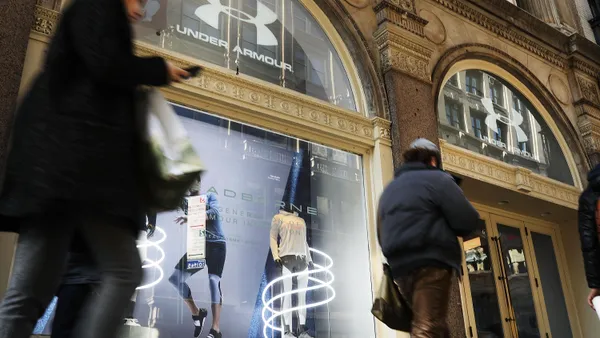Dive Brief:
-
Wal-Mart is aggressively cutting prices to wrestle back market share from the likes of dollar stores and Target, and that could hurt those rivals to the tune of $35 billion worth of business, according to a UBS research paper cited by Fortune.
-
In recent months, Dollar General has stepped up price competition by taking bold steps to cut prices as much as 10% in order to drive sales and customer traffic, with an emphasis on its core lower-income customer segment, Dollar General CEO Todd Vasos said on a conference call with analysts in August.
-
Target CEO Brian Cornell also said last month that the retailer would take steps to emphasize the “pay less” part of its “Expect More, Pay Less” tagline. However, UBS analyst Michael Lasser said Target could be especially vulnerable because its stores are often within driving distance of a Wal-Mart and the retailer has been struggling in grocery, which provides more than half of Wal-Mart’s revenues, Fortune reports.
Dive Insight:
Wal-Mart has a long-held reputation for low prices — Sam Walton built his empire on the promise of “always low prices,” after all. Its massive scale and penchant for playing hardball with suppliers has also made it difficult for rivals to compete.
Decades ago, well before Amazon’s e-commerce disruption, Target learned the perils of competitive pricing firsthand. Frustrated by its perennial place in the shadow of Wal-Mart’s “always low prices” bulwark, Target initiated a price war, according to Mark Cohen, a professor of retail studies at Columbia University.
Things didn’t go well, recalls Cohen, who worked for Target’s parent company at the time. Target was blindsided by Wal-Mart’s willingness to forgo profits. While Target attached “limit six per customer” signs on drastically reduced items, for example, Wal-Mart was willing to ship in bulk to other retail operations that found price-war items tagged below wholesale prices.
Target soon conceded defeat in this race to the bottom on price, Cohen said, and immediately began to contemplate other ways to compete — a process that resulted in its now-signature “cheap chic” efforts and the idea of collaborating with upscale designers for mass market goods.
In recent years, before its debilitating data breach in 2013, Target has lost sight of that "cheap chic" focus. But under CEO Brian Cornell, it has been working to get it back. While UBS’s Lasser believes Target could be vulnerable to Wal-Mart’s pricing stance, differentiation could be Target's salvation. Even for Wal-Mart, price can be a dubious way to compete, and it could interfere with that retailer’s stated aim of attracting more wealthy customers.
“Price has emerged as a bigger-than-life issue that is enormously complicated," Cohen told Retail Dive. "How do you put an assortment into a 200,000-square foot plain vanilla box that is inviting, engaging and happy, and makes you want to come back? You have to do it with merchandise and with merchandise presentation.”













